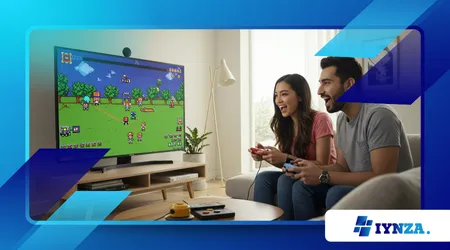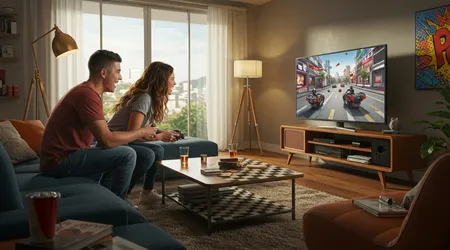The New Wave of Couch Co-Op: Retro Style, Modern Heart

The new wave of couch co-op gaming is reshaping how we connect, blending nostalgic pixel art with modern innovation.
Anúncios
Picture this: you’re sprawled on a couch with friends, controllers in hand, laughter erupting as you tackle chaotic challenges together.
This isn’t just gaming it’s a social revival rooted in retro aesthetics but pulsing with contemporary creativity.
In 2025, indie developers are driving this resurgence, crafting experiences that echo the golden age of arcade and console gaming while weaving in fresh mechanics and inclusive storytelling.
Why does this matter? Because couch co-op is more than a genre; it’s a bridge to shared memories and new bonds, perfectly suited for today’s craving for authentic connection.
This article dives into the new wave of couch co-op, exploring its retro-inspired roots, modern innovations, and cultural impact.
We’ll uncover why these games resonate, spotlight standout titles, and offer practical insights for gamers and developers alike.
From pixelated platformers to intricate RPGs, the genre is thriving, fueled by indie studios unafraid to experiment.
With real-world examples, a fresh statistic, and a vivid analogy, we’ll navigate this vibrant landscape. Ready to rediscover the joy of gaming side by side? Let’s explore what makes this movement so captivating.
The Retro Revival: Nostalgia Meets Innovation
Couch co-op games hark back to the days of split-screen battles and arcade cabinets. Think Double Dragon or Streets of Rage titles that defined social gaming.
Today’s new wave of couch co-op channels that energy, using pixel art and chiptune soundtracks to evoke nostalgia. Yet, these games aren’t stuck in the past.
Indie developers infuse them with modern mechanics, like dynamic difficulty or procedural levels, ensuring replayability.
Take Sea of Stars, a 2023 indie JRPG that sold over 5 million copies. Its 2024 three-player co-op mode, “Single Player+,” introduced co-op timed hits, blending turn-based combat with real-time teamwork.
This fusion keeps the retro spirit alive while feeling fresh. Nostalgia draws players in, but innovation keeps them hooked.
++ Is the NES Back? Why New Games Are Still Being Made for Old Consoles
Another gem, Teenage Mutant Ninja Turtles: Shredder’s Revenge (2022), supports up to six players. Its pixelated brawler style recalls 90s arcades, but online integration and fluid controls modernize the experience.
These titles show how developers balance reverence for the past with forward-thinking design, making couch co-op irresistible.
The appeal lies in accessibility. Retro aesthetics lower development costs, letting small studios focus on tight gameplay. Meanwhile, modern touches like cross-platform play broaden the audience.
This synergy creates experiences that feel both familiar and groundbreaking, inviting players of all ages to join the fun.

Why Couch Co-Op Matters in 2025
In an era of online multiplayer dominance, why is the new wave of couch co-op thriving? It’s simple: people crave real connection.
After years of digital fatigue, gamers want shared physical spaces. A 2024 MIDiA Research report found 20% of gamers prefer couch co-op, especially younger players aged 16-19. This demand drives indie studios to fill the gap left by AAA titles.
Couch co-op fosters teamwork and camaraderie. Games like Overcooked! All You Can Eat thrive on chaotic collaboration, turning kitchens into battlegrounds of hilarity.
Players shout, strategize, and laugh, creating memories no online match can replicate. These moments are the heart of the genre’s resurgence.
Also read: Exploring the Underground: The Best Indie Games You’ve Never Heard Of (Yet)
Moreover, couch co-op is inclusive. Titles like Pikwip on itch.io cater to casual players with simple mechanics, while Chained Echoes offers deep RPG systems for hardcore fans.
This diversity ensures everyone finds a game to share, from kids to seasoned gamers.
The genre also taps into cultural trends. As remote work and digital interactions grow, people seek tangible experiences.
Couch co-op delivers, transforming living rooms into hubs of joy. It’s a rebellion against isolation, proving gaming can be profoundly social.
Standout Titles Leading the Charge
The new wave of couch co-op shines through innovative indie games. It Takes Two (2021), with over 20 million copies sold, redefined co-op storytelling.
Its narrative-driven puzzles require true collaboration, blending retro charm with cinematic depth. Players control a couple navigating divorce, making every level emotionally resonant.
Spacelines from the Far Out offers a quirky take, letting 2-4 players run a retro-space airline. Its randomized challenges and vibrant art echo 80s sci-fi, but modern humor keeps it fresh.
The game’s chaotic fun thrives in shared spaces, perfect for group play.
Then there’s Pikwip, a free itch.io title where alien kids clean up Earth. Its simple controls and cooperative focus make it ideal for families.
These games highlight the genre’s range, from emotional depth to lighthearted chaos, all rooted in retro-inspired design.
Read more: How ‘Chained Echoes’ Became the Spiritual Successor JRPG Fans Were Waiting For
For a deeper dive, Boomerang Fu delivers fast-paced brawler action for up to six players. Its colorful, cartoonish style masks a high skill ceiling, appealing to competitive friends.
Each title shows how indies innovate, making couch co-op a vibrant space in 2025.
Here’s a snapshot of standout titles driving the new wave of couch co-op:
| Game | Players | Platform | Key Feature |
|---|---|---|---|
| Sea of Stars | 1-3 | PC, Switch, PlayStation | Co-op timed hits |
| It Takes Two | 2 | PC, PlayStation, Xbox | Narrative-driven puzzles |
| Spacelines from the Far Out | 2-4 | PC, Xbox | Randomized co-op challenges |
| Boomerang Fu | 2-6 | PC, Switch, PlayStation, Xbox | Fast-paced brawler mechanics |
The Developer’s Playbook: Crafting Co-Op Magic
Indie developers are the architects of the new wave of couch co-op, leveraging creativity over budgets.
Limited resources push innovation, like Pikwip’s minimalist design, which maximizes fun through cooperative objectives. Small teams focus on tight mechanics, ensuring every interaction feels meaningful.
Storytelling enhances engagement. It Takes Two weaves a heartfelt narrative into its puzzles, making players care about their journey.
This emotional hook, paired with retro visuals, creates lasting impact. Developers also use scalable difficulty to welcome diverse skill levels, broadening appeal.
Social media amplifies reach. Studios like Sabotage engage fans on X, teasing updates like Sea of Stars’ co-op mode, sparking excitement.
Sharing dev logs or funny bugs, as seen with Boyfriend Dungeon, builds community trust and involvement.
Cross-platform play is another game-changer. Titles like Shredder’s Revenge support seamless multiplayer across consoles, ensuring friends can play together regardless of device.
This accessibility, combined with retro aesthetics, fuels the genre’s growth.
Finally, developers tap into game jams, like Ludum Dare 56, to prototype co-op ideas. These events foster creativity, producing gems like My Rusty Submarine, a quirky co-op adventure.
By blending passion and pragmatism, indies keep the new wave of couch co-op vibrant.
Challenges and Opportunities Ahead
Despite its rise, the new wave of couch co-op faces hurdles. Developing for local multiplayer demands precise balancing to avoid frustration.
Uneven difficulty can alienate players, as seen in early Overcooked levels, where chaos overwhelmed novices. Indies must test rigorously to ensure accessibility.
Market saturation is another risk. With indie games flooding platforms like itch.io, standing out requires unique hooks.
Cuphead’s brutal difficulty and 1930s cartoon style set it apart, but not every studio can replicate such distinctiveness. Creative marketing is crucial.
Yet, opportunities abound. The genre’s low-budget appeal suits indie studios, allowing experimentation with mechanics like Sea of Stars’ co-op timed hits.
Niche communities on Reddit and X offer direct feedback, helping developers refine their vision and build loyal fanbases.
Collaborations with IPs, like a hypothetical Frozen-themed co-op platformer, could draw mainstream attention.
Nintendo’s success with Super Mario Bros. Wonder shows how family-friendly co-op thrives. Indies can capitalize on this hunger for shared experiences.
Analogy time: couch co-op is like a potluck dinner. Everyone brings something unique retro visuals, modern mechanics, or heartfelt stories creating a feast of fun.
Developers who blend these ingredients thoughtfully will shape the genre’s future.
The Cultural Impact: Redefining Social Gaming

Couch co-op is more than a gaming trend; it’s a cultural movement. In 2025, as digital overload pushes people toward real-world connections, these games offer a haven.
They transform living rooms into arenas of laughter and strategy, strengthening bonds in a fragmented world.
Take Magic Panic, a 1-4 player co-op game on itch.io. Its simple premise defending against waves of enemies sparks teamwork and chaos, perfect for friend groups.
Such titles foster inclusivity, letting players of all skill levels share the fun, unlike competitive online shooters.
The genre also inspires creativity. Fan art, cosplay, and streams thrive around games like Boyfriend Dungeon, where players engage with romanceable characters.
This community-driven energy amplifies the new wave of couch co-op, making it a cultural touchstone.
Moreover, couch co-op bridges generations. Parents and kids bond over Cat Quest II, its gentle RPG mechanics welcoming all. This intergenerational appeal cements the genre’s role as a social glue, uniting diverse players.
What’s next? As VR and AR evolve, imagine couch co-op integrating immersive tech, blending retro charm with futuristic flair. The genre’s heart shared joy will keep it thriving, redefining how we play together.
Conclusion: The Heartbeat of Shared Play
The new wave of couch co-op is a love letter to gaming’s past and a bold step into its future. It’s the thrill of passing a controller, the chaos of shouting strategies, the joy of shared victories.
Indie studios, with their retro-inspired yet innovative designs, are breathing life into this genre, making it a cultural force in 2025.
From Sea of Stars to Spacelines from the Far Out, these games prove that simple mechanics and heartfelt stories can create unforgettable experiences.
This resurgence isn’t just about nostalgia; it’s about connection. In a world craving authentic interactions, couch co-op delivers.
Whether you’re a gamer seeking fun or a developer crafting the next hit, this wave offers endless possibilities.
So, grab a friend, pick a game, and dive in why play alone when you can share the adventure? The couch is calling, and the new wave of couch co-op is here to stay.
Frequently Asked Questions
What makes couch co-op different from online multiplayer?
Couch co-op involves players in the same physical space, using one screen, fostering direct interaction. Online multiplayer connects players remotely, often lacking the same social energy.
Are there free couch co-op games available?
Yes, platforms like itch.io offer free titles like Pikwip and My Rusty Submarine, perfect for budget-friendly local multiplayer fun with retro vibes.
How can developers make their couch co-op games stand out?
Focus on unique mechanics, like Sea of Stars’ co-op timed hits, and engage communities on X or Reddit for feedback and visibility.
Why is retro style popular in couch co-op games?
Retro aesthetics evoke nostalgia, are cost-effective for indie devs, and pair well with modern mechanics, creating accessible, visually distinct experiences.
Can couch co-op work for solo players?
Some games, like Sea of Stars’ Single Player+ mode, adapt co-op mechanics for solo play, but the genre shines brightest with friends.
Citations:
